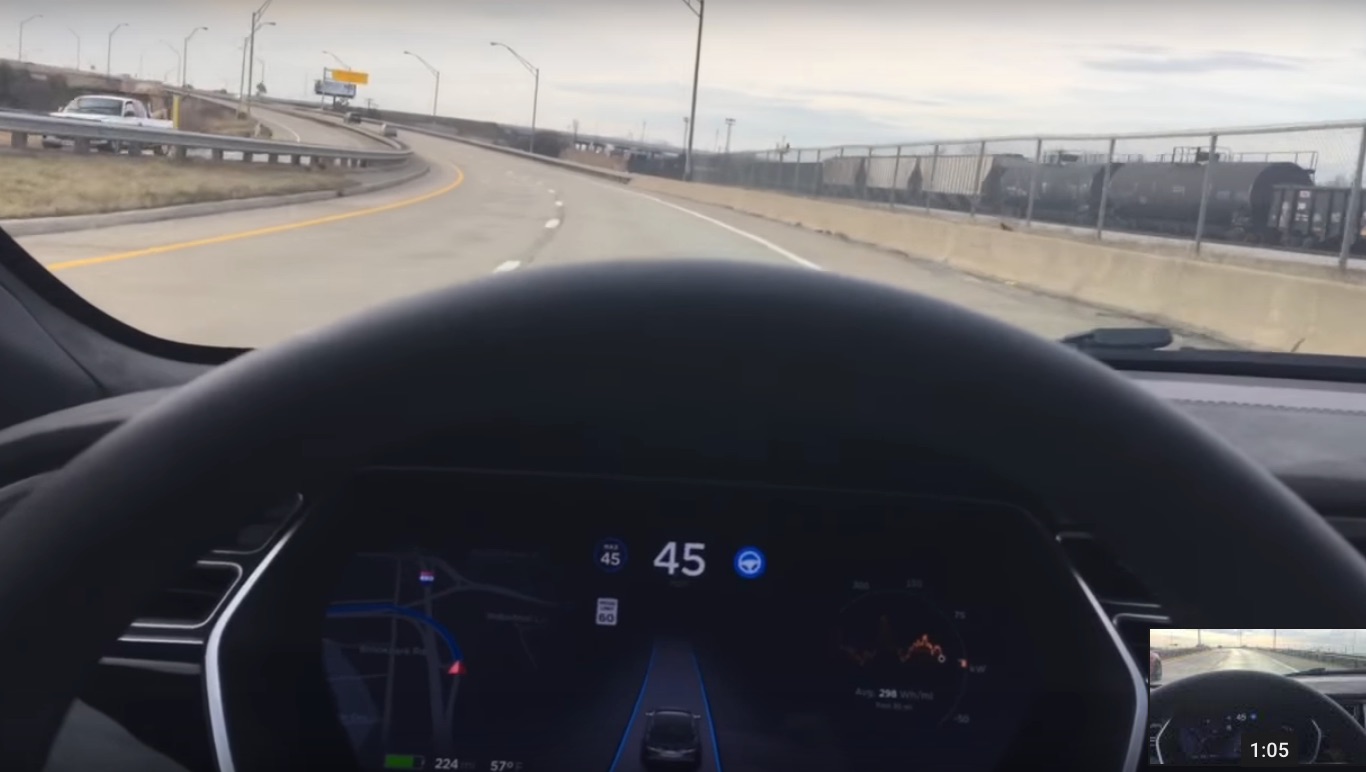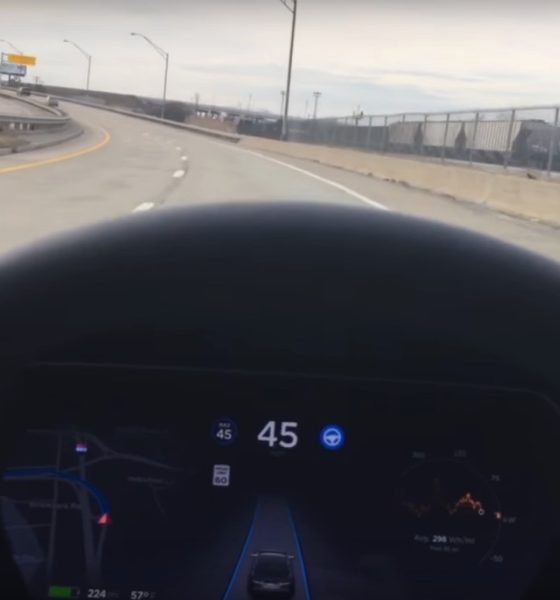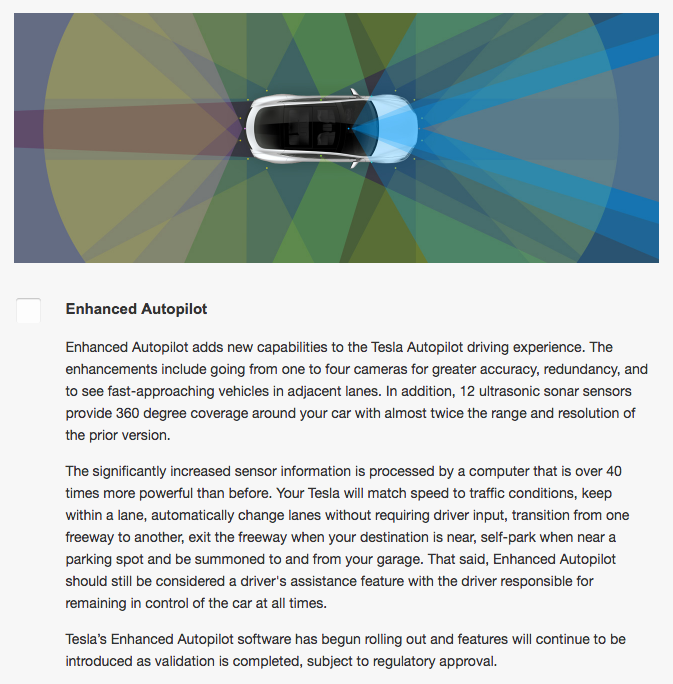

News
Tesla fires back at new class-action suit that alleges “inoperative standard safety features” on Autopilot 2.0 cars
Tesla has been transparent about its Enhanced Autopilot software which the company said would roll out incrementally over time, but that hasn’t stopped HBSS Law firm from filing a new class-action suit today, alleging that Tesla deceitfully sold “inoperative Standard Safety Features” on cars that “lack basic functions featured in cars at half the price”. In question is, what the suit describes as, “nonfunctional” Autopilot 2.0 software, an optional feature available on Model S and Model X vehicles equipped with self-driving hardware.
Tesla responded to the suit, slamming the credibility of the claims being made, stating:
“This lawsuit is a disingenuous attempt to secure attorney’s fees posing as a legitimate legal action, which is evidenced by the fact that the suit misrepresents many facts. Many of the features this suit claims are “unavailable” are in fact available, with more updates coming every month. We have always been transparent about the fact that Enhanced Autopilot software is a product that would roll out incrementally over time, and that features would continue to be introduced as validation is completed, subject to regulatory approval.
Furthermore, we have never claimed our vehicles already have functional “full self-driving capability”, as our website has stated in plain English for all potential customers that “it is not possible to know exactly when each element of the functionality described above will be available, as this is highly dependent on local regulatory approval.” The inaccurate and sensationalistic view of our technology put forth by this group is exactly the kind of misinformation that threatens to harm consumer safety.”
The new class-action suit alleges that the California electric car maker knowingly sold nearly 50,000 vehicles equipped with self-driving Autopilot 2.0 hardware and the promise that Enhanced Autopilot hardware “still has not met Tesla’s promises” and was missing standard safety features.
The suit specifically takes issue with the Enhanced Autopilot feature of Tesla vehicles noting that, “the “Enhanced Autopilot,” for which customers paid an extra $5,000, is ‘essentially unusable and demonstrably dangerous.’”
The Tesla purchase page for the Model S “Tesla’s Enhanced Autopilot software has begun rolling out and features will continue to be introduced as validation is completed, subject to regulatory approval.”
The suit takes issue with the “beta” nature of the Enhanced Autopilot software, alleging that Tesla knew that it could not do what Tesla claimed it would do. It states that “the automaker knew that its software was incapable of upholding its promises to purchasers.”
Steve Berman a managing partner of Hagens Berman which represents the plaintiffs, shared:
“Tesla has endangered the lives of tens of thousands of Tesla owners across the country, and induced them to pay many thousands of dollars for a product that Tesla has not effectively designed. Tesla sold these vehicles as the safest sedan on the road. What consumers received were cars without standard safety enhancements featured by cars costing less than half the price of a new Tesla, and a purported ‘Enhanced Autopilot’ that operates in an erratic and dangerous manner.”
The suit compares the safety features available in Tesla vehicles to those available on “cars costing less than half the price of a new Tesla.” Tesla’s over-the-air update of firmware 8.1 aimed to bring Enhanced Autopilot to near feature parity with Model S and Model X vehicles equipped with first generation Autopilot 1.0. Here’s an excerpt from our coverage of firmware version 8.1, when it was first introduced:
Vehicles equipped with Tesla’s Autopilot 2.0 feature and self-driving sensors, also commonly referred to as “hardware 2” (HW2), will see improvements to Autosteer, lifting a previous speed cap set at 55 mph (88 mkh) to 80 mph (129 kmh). The update also adds the Auto Lane Change feature and Tesla Summon, which until now was only available on first-generation Autopilot cars. Tesla’s Lane Departure Warning feature has also been added to Autopilot 2.0 which will vibrate the steering wheel if the vehicle veers from its intended driving lane when speeds reach above 36 mph (58 kmh).
Berman doesn’t see it that way, stating that “to this day, Tesla has not released truly functional software for its Standard Safety Features or Enhanced Autopilot.”
The suit lists out the specific issues it takes with the “missing” Standard Safety Features:
“Regarding its Standard Safety Features which include automatic emergency braking, front collision warning, side collision warning and auto high beams, Tesla told consumers these features would be available by December 2016 and ‘roll out through over-the-air software updates,’ but to date, only a dangerously defective Traffic Aware Cruise Control has actually come to fruition, according to the suit. The remaining features simply do not exist.”
In scope of the class-action lawsuit are “about 47,000 affected Model S and Model X vehicles.” The suit seeks the value of the standard safety features that do not exist in these cars plus $5,000 for the “nonfunctional Enhanced Autopilot feature” that many owners purchased as an option to their vehicle.

News
Tesla FSD fleet is nearing 7 billion total miles, including 2.5 billion city miles
As can be seen on Tesla’s official FSD webpage, vehicles equipped with the system have now navigated over 6.99 billion miles.

Tesla’s Full Self-Driving (Supervised) fleet is closing in on almost 7 billion total miles driven, as per data posted by the company on its official FSD webpage.
These figures hint at the massive scale of data fueling Tesla’s rapid FSD improvements, which have been quite notable as of late.
FSD mileage milestones
As can be seen on Tesla’s official FSD webpage, vehicles equipped with the system have now navigated over 6.99 billion miles. Tesla owner and avid FSD tester Whole Mars Catalog also shared a screenshot indicating that from the nearly 7 billion miles traveled by the FSD fleet, more than 2.5 billion miles were driven inside cities.
City miles are particularly valuable for complex urban scenarios like unprotected turns, pedestrian interactions, and traffic lights. This is also the difference-maker for FSD, as only complex solutions, such as Waymo’s self-driving taxis, operate similarly on inner-city streets. And even then, incidents such as the San Francisco blackouts have proven challenging for sensor-rich vehicles like Waymos.
Tesla’s data edge
Tesla has a number of advantages in the autonomous vehicle sector, one of which is the size of its fleet and the number of vehicles training FSD on real-world roads. Tesla’s nearly 7 billion FSD miles then allow the company to roll out updates that make its vehicles behave like they are being driven by experienced drivers, even if they are operating on their own.
So notable are Tesla’s improvements to FSD that NVIDIA Director of Robotics Jim Fan, after experiencing FSD v14, noted that the system is the first AI that passes what he described as a “Physical Turing Test.”
“Despite knowing exactly how robot learning works, I still find it magical watching the steering wheel turn by itself. First it feels surreal, next it becomes routine. Then, like the smartphone, taking it away actively hurts. This is how humanity gets rewired and glued to god-like technologies,” Fan wrote in a post on X.
News
Tesla starts showing how FSD will change lives in Europe
Local officials tested the system on narrow country roads and were impressed by FSD’s smooth, human-like driving, with some calling the service a game-changer for everyday life in areas that are far from urban centers.

Tesla has launched Europe’s first public shuttle service using Full Self-Driving (Supervised) in the rural Eifelkreis Bitburg-Prüm region of Germany, demonstrating how the technology can restore independence and mobility for people who struggle with limited transport options.
Local officials tested the system on narrow country roads and were impressed by FSD’s smooth, human-like driving, with some calling the service a game-changer for everyday life in areas that are far from urban centers.
Officials see real impact on rural residents
Arzfeld Mayor Johannes Kuhl and District Administrator Andreas Kruppert personally tested the Tesla shuttle service. This allowed them to see just how well FSD navigated winding lanes and rural roads confidently. Kruppert said, “Autonomous driving sounds like science fiction to many, but we simply see here that it works totally well in rural regions too.” Kuhl, for his part, also noted that FSD “feels like a very experienced driver.”
The pilot complements the area’s “Citizen Bus” program, which provides on-demand rides for elderly residents who can no longer drive themselves. Tesla Europe shared a video of a demonstration of the service, highlighting how FSD gives people their freedom back, even in places where public transport is not as prevalent.
What the Ministry for Economic Affairs and Transport says
Rhineland-Palatinate’s Minister Daniela Schmitt supported the project, praising the collaboration that made this “first of its kind in Europe” possible. As per the ministry, the rural rollout for the service shows FSD’s potential beyond major cities, and it delivers tangible benefits like grocery runs, doctor visits, and social connections for isolated residents.
“Reliable and flexible mobility is especially vital in rural areas. With the launch of a shuttle service using self-driving vehicles (FSD supervised) by Tesla in the Eifelkreis Bitburg-Prüm, an innovative pilot project is now getting underway that complements local community bus services. It is the first project of its kind in Europe.
“The result is a real gain for rural mobility: greater accessibility, more flexibility and tangible benefits for everyday life. A strong signal for innovation, cooperation and future-oriented mobility beyond urban centers,” the ministry wrote in a LinkedIn post.
News
Tesla China quietly posts Robotaxi-related job listing
Tesla China is currently seeking a Low Voltage Electrical Engineer to work on circuit board design for the company’s autonomous vehicles.

Tesla has posted a new job listing in Shanghai explicitly tied to its Robotaxi program, fueling speculation that the company is preparing to launch its dedicated autonomous ride-hailing service in China.
As noted in the listing, Tesla China is currently seeking a Low Voltage Electrical Engineer to work on circuit board design for the company’s autonomous vehicles.
Robotaxi-specific role
The listing, which was shared on social media platform X by industry watcher @tslaming, suggested that Tesla China is looking to fill the role urgently. The job listing itself specifically mentions that the person hired for the role will be working on the Low Voltage Hardware team, which would design the circuit boards that would serve as the nervous system of the Robotaxi.
Key tasks for the role, as indicated in the job listing, include collaboration with PCB layout, firmware, mechanical, program management, and validation teams, among other responsibilities. The role is based in Shanghai.
China Robotaxi launch
China represents a massive potential market for robotaxis, with its dense urban centers and supportive policies in select cities. Tesla has limited permission to roll out FSD in the country, though despite this, its vehicles have been hailed as among the best in the market when it comes to autonomous features. So far, at least, it appears that China supports Tesla’s FSD and Robotaxi rollout.
This was hinted at in November, when Tesla brought the Cybercab to the 8th China International Import Expo (CIIE) in Shanghai, marking the first time that the autonomous two-seater was brought to the Asia-Pacific region. The vehicle, despite not having a release date in China, received a significant amount of interest among the event’s attendees.








